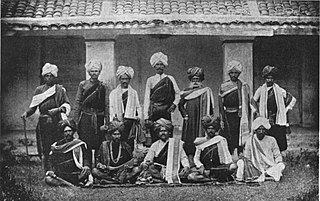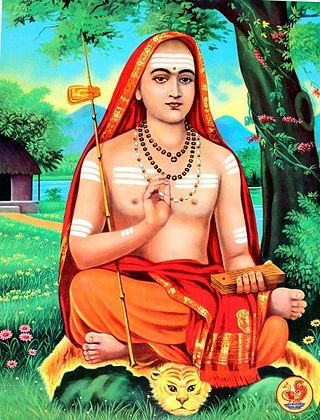Related Research Articles
Saraswat Brahmins are Hindu Brahmins, who are spread over widely separated regions spanning from Kashmir in North India to Konkan in West India to Kanara and Kerala in South India. The word Saraswat is derived from the Rigvedic Sarasvati River.
Niyogi Brahmin is a Telugu Brahmin subcaste native to the Indian states of Andhra Pradesh and Telangana, but are spread throughout South India and Maharashtra. The traditional occupations of the Niyogi Brahmins are settled cultivation and priesthood. But majority of them took up various secular vocations including military activities and patwaris. They were associated with administration, economics, literature, music composing, politics, scholarly, scientific, engineering, defense and warfare careers.
Kota Brahmins are a Hindu Brahmin subcaste mainly from the Indian state of Karnataka. Kota Brahmins take their name from their native village Kota. They speak a Kannada different from the other regional dialects. Kota Brahmins are mainly concentrated in the villages of Kota of Udupi district. Kotas follow Smarta tradition. The Guru Narasimha Temple, Saligrama is important to them.
Deshastha Brahmin is a Hindu Brahmin subcaste mainly from the Indian state of Maharashtra and North Karnataka. Other than these states, according to authors K. S. Singh, Gregory Naik and Pran Nath Chopra, Deshastha Brahmins are also concentrated in the states of Telangana (which was earlier part of Hyderabad State and Berar Division), Andhra Pradesh and Madhya Pradesh (Which was earlier part of Central Provinces and Berar) Historian Pran Nath Chopra and journalist Pritish Nandy say, "Most of the well-known saints from Maharashtra, Karnataka and Andhra Pradesh were Deshastha Brahmins". The mother tongue of Deshastha Brahmins is either Marathi, Kannada or Telugu.
Telugu Brahmins are Telugu-speaking Brahmin communities native to the Indian states of Andhra Pradesh and Telangana. They fall under the Pancha Dravida Brahmin classification of the Brahmin community in India. Telugu Brahmins are further divided into sections like Vaidiki, Niyogi, Deshastha, Dravida and Golkonda Vyapari.

Vokkaliga is a community, or a group of closely related castes, from the Indian state of Karnataka. They are also present in the neighbouring state of Tamil Nadu.
Dravida Brahmins, or simply Dravidulu, is a sub-caste of the Telugu Brahmins of Andhra Pradesh in South India, who migrated from Tamil-speaking regions. They are further divided into sub-sects based on the places where they have settled such as Aaraama Dravidulu, Pudur Dravidulu, Konaseema Dravidulu, Peruru Dravidulu, Tummagunta Dravidulu and Dimili Dravidulu.

Kashi Math is a matha (monastery) and a spiritual organisation followed by the Madhva section of Gaud Saraswat Brahmins, who are also referred as Madhwa Saraswat Brahmins or Vaishnava Saraswat Brahmins. It dates back to the 16th century. With its headquarters in Brahma Ghat, Varanasi. Kashi Math has followers all over the Konkan belt, prominently in Mumbai, Goa, Udupi, Mangalore, Kochi and other parts of Karnataka and Kerala.

Gaud Saraswat Brahmins (GSB) are a Hindu Brahmin community, who are part of the larger Saraswat Brahmin community that migrated to Konkan from Gaud, as per the Skanda Purana in ancient India. They belong to the Pancha Gauda Brahmins group.They primarily speak Konkani and its various dialects as their mother tongue.
Karnataka, with a total population of 61,100,000, is one of the major states in South India. Kannada is the official language of Karnataka. Other linguistic minorities in the state are Tulu, Kodava, Konkani and Urdu. Karnataka is also in the forefront of population control measures with the world's first two birth control clinics being set up in 1930 in the Mandya district.
Pancha Dravida is one of the two major groupings of Brahmins in Hinduism, of which the other was Pancha-Gauda.

Shri Uttaradi Math, is one of the main monasteries (matha) founded by Madhvacharya with Padmanabha Tirtha as its head to preserve and propagate Dvaita Vedanta (Tattvavada) outside Tulunadu region. Uttaradi Math is one of the three premier Dvaita monasteries or Mathatraya that descended from Madhvacharya in the lineage of Padmanabha Tirtha through Jayatirtha. After Jayatirtha and Vidyadhiraja Tirtha, Uttaradi Math continued in the lineage of Kavindra Tirtha and later in the lineage of Vidyanidhi Tirtha. The Moola Rama and Moola Sita idols worshipped in the Uttaradi Matha have a long history and are revered for their great divinity.

Mayasandra is a village in Turuvekere taluk in Tumkur District in Karnataka State in India. The place is one of the pancha-gramas of the Hebbar Shrivaishnavas and has an old temple of Mayamma which is revered by the Bestas and a shakti temple of Koollapuradamma, and a granite Jain temple of Parshwanath. The Lake of Mayasandra a big lake in the taluk.
Pattegar is a Hindu community predominantly residing in the Indian states of Karnataka, Maharashtra, Andhra Pradesh and Telangana. They wear the sacred thread and are Kshatriyas. They are Somavamshiya Sahasrarjun Kshatriyas or SSK Samaj. and are given reservation in Maharashtra.
Vaidiki Velanadu is a sub-caste of Telugu speaking Smarta Brahmins whose ancestral roots lie in velanadu region, the ancient name for the coastal region on the banks of River Krishna in the Guntur district and Prakasam district. Some may have roots in Northern Andhra Pradesh near Vishakapatnam or Srikakulam. They are classified as Pancha-Dravida brahmins. They are predominantly followers of Adi Shankaracharya and are located in Andhra Pradesh. However, There is a small subset of them who remain Shrauta brahmins. Most Vaidiki Velanadu Brahmins follow the Apastamba Dharmasutra and belong to the Taittiriya Shakha of the Krishna Yajur Veda.

Madhva Brahmins, are Hindu Brahmin communities in India, who follow Sat Vaishnavism and Dvaita philosophy propounded by Madhvacharya. They are found mostly in the Indian states of Karnataka, Maharashtra, Goa, Tamil Nadu, Kerala, Telangana and Andhra Pradesh.

The Babburkamme are a community of Brahmins in India. They belong to Hindu Pancha Dravida Smartha Brahmin. They have been holding highly politically influencing position such ministers, chief priests, scholars and poets under different kingdoms. A related community are today known as Uluchu Kamme has Kannada as their mother tongue.
Kannada Brahmins are Kannada-speaking Brahmins, primarily living in Karnataka, and also present in the states of Telangana, Andhra Pradesh, Kerala, and Tamil Nadu. They belong to one of three traditions: Smartism, Sadh Vaishnavism, and Sri Vaishnavism, and are followers of Adi Shankara, Madhvacharya, and Ramanuja respectively.
Koteshwara Brahmins are a Hindu Brahmin subcaste mainly from the Indian state of Karnataka. The community is mainly concentrated in the Koteshwara, Kundapur, and surrounding areas of Udupi district in Karnataka. The community takes its name from the village Koteshwara, which is their native place. Koteshwara Brahmins follows the Dvaita Vedanta propounded by Madhvacharya and are followers of Sodhe Vadiraja Swami Matha.
Chandra Varma is the name of the legendary ancestor of the Kodavas.
References
- ↑ Karnataka State Gazetteer: Mysore. Director of Print, Stationery and Publications at the Government Press. 1988. p. 157.
Of the two broad divisions among the brahmins, the Pancha Gowda of the north and the Pancha Dravida of the south, the brahmins of the Karnataka belong to the latter. There are the four linguistic groups speaking Kannada, Tamil, Telugu and Malayalam.
- ↑ P. P. Nārāyanan Nambūdiri (1992). Aryans in South India. Inter-India Publications. p. 76. ISBN 9788121002660.
The Canarese or the Karnataka Brahmins The Canarese speaking or Karnataka brahmins are divided into two major sub-divisions, the Smarta and Madhwa with several sub- divisions under each.
- ↑ Karnataka State Gazetteer: Mysore. Director of Print, Stationery and Publications at the Government Press. 1988. p. 157.
All the Brahmins belong to one of the three sects, i.e., the Smarthas, the Madhwa and the Srivaishnava, followers of Shankaracharya, Madhwacharya and Ramanujacharya.